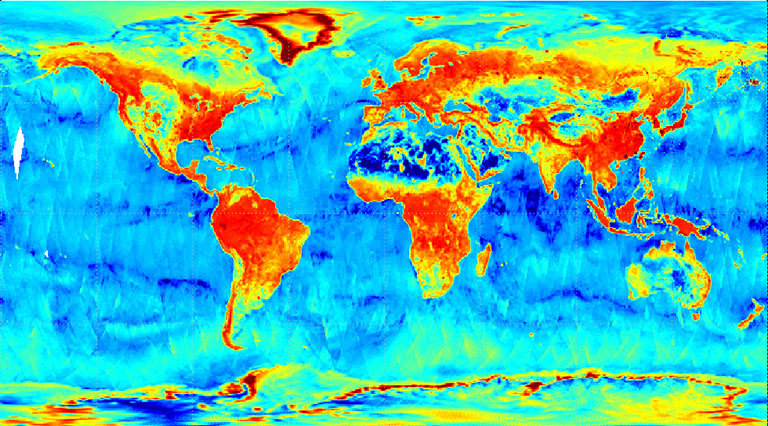Mission to Mars Launching from Santa Barbara
Go Behind the Scenes of NASA’s First Interplanetary Effort from Vandenberg Air Force Base
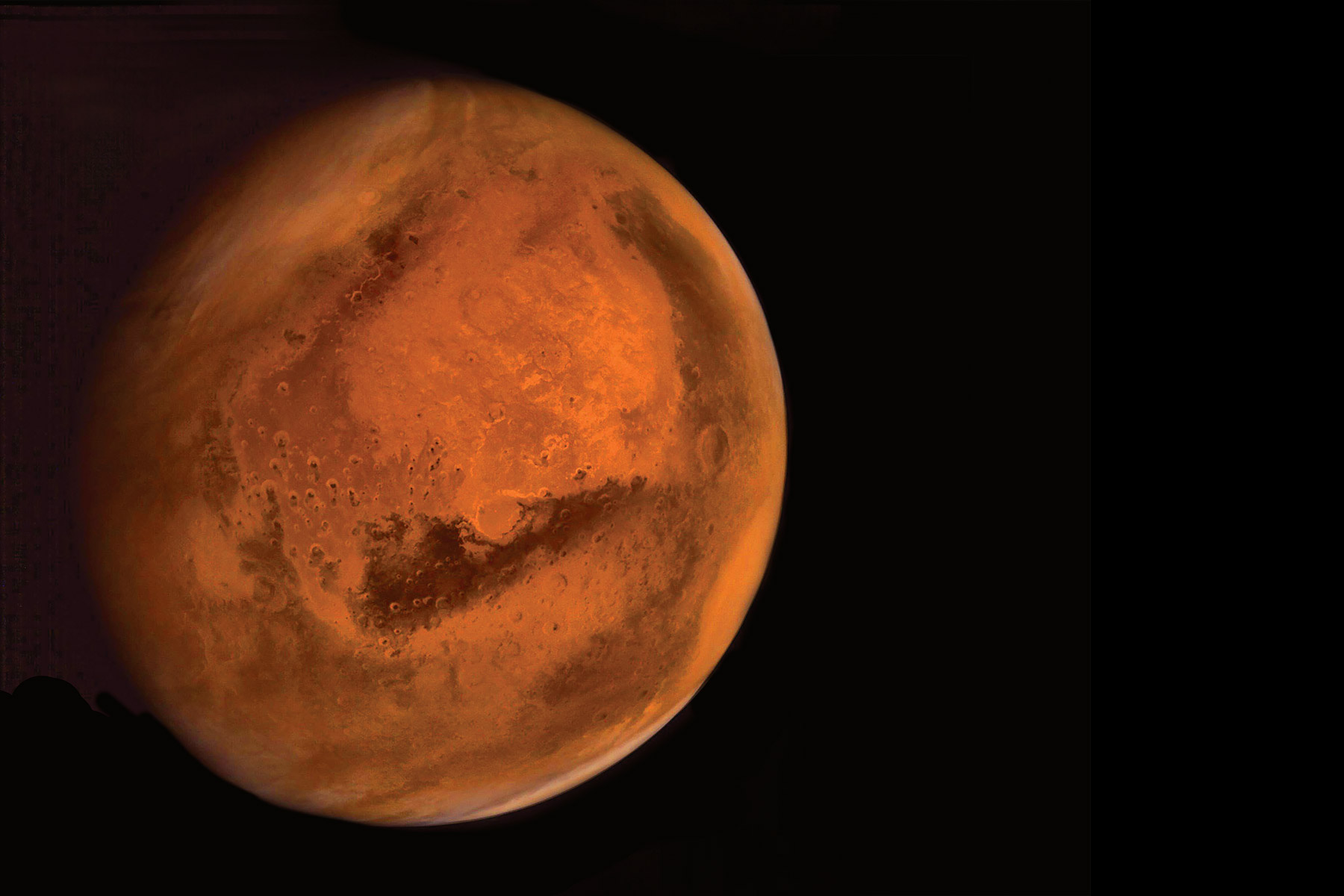
It happens all the time. A rocket leaps off its seaside launch pad at Vandenberg Air Force Base, rattles windows and eardrums in nearby Lompoc, trails an arch of hot exhaust over the Pacific, and then disappears into the wild blue yonder. The whole sequence lasts just a few minutes. Most of us don’t pay much attention. Another test missile here, another NASA satellite there. Big deal.
Though space launches have become routine — with nearly 2,000 over Vandenberg’s 60-year history — it doesn’t make these symphonies of mathematical precision and violent energy any less remarkable. And while it’s true that the base’s main mission is national security — conducting show-of-force test launches of nuclear missiles and lofting spy satellites into orbit — Vandenberg is also the starting point of some of the most advanced and exciting scientific explorations of our time.
On May 5, at 4:05 a.m., a 30-day launch window opens for the National Aeronautics and Space Administration’s (NASA) next mission to Mars. When the weather is clear and the planets align just right, an Atlas V rocket will send the $814 million InSight lander on a six-month journey from Vandenberg toward our heavenly neighbor in the agency’s first launch to another planet from the West Coast. InSight will probe under Mars’s rusty surface and take its vital signs: pulse, through “marsquakes” readings; temperature, via heat-flow signatures; and reflexes, with radio testing.
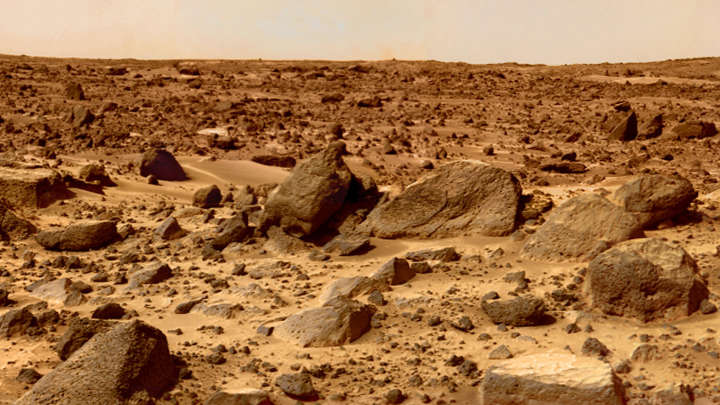
The data it beams back over the next two years will help us unravel the geological mysteries of the solar system’s rocky bodies, including Earth, and answer a key question that’s always confounded scientists: Our home planet and Mars were molded from the same primordial stuff more than 4.5 billion years ago. Why did they become so different? What researchers learn will also aid our search for sentience among the stars by narrowing down which planets might be able to support life.
Earlier this month, NASA offered reporters a chance to meet InSight in person and chat with some of the agency’s biggest brains. Here, we’ll walk you through that amazing and bizarre 20 minutes inside a highly secure Vandenberg clean room, talk more about how the lander works, and highlight other space science missions that trace their beginnings to a slice of Santa Barbara coastline.
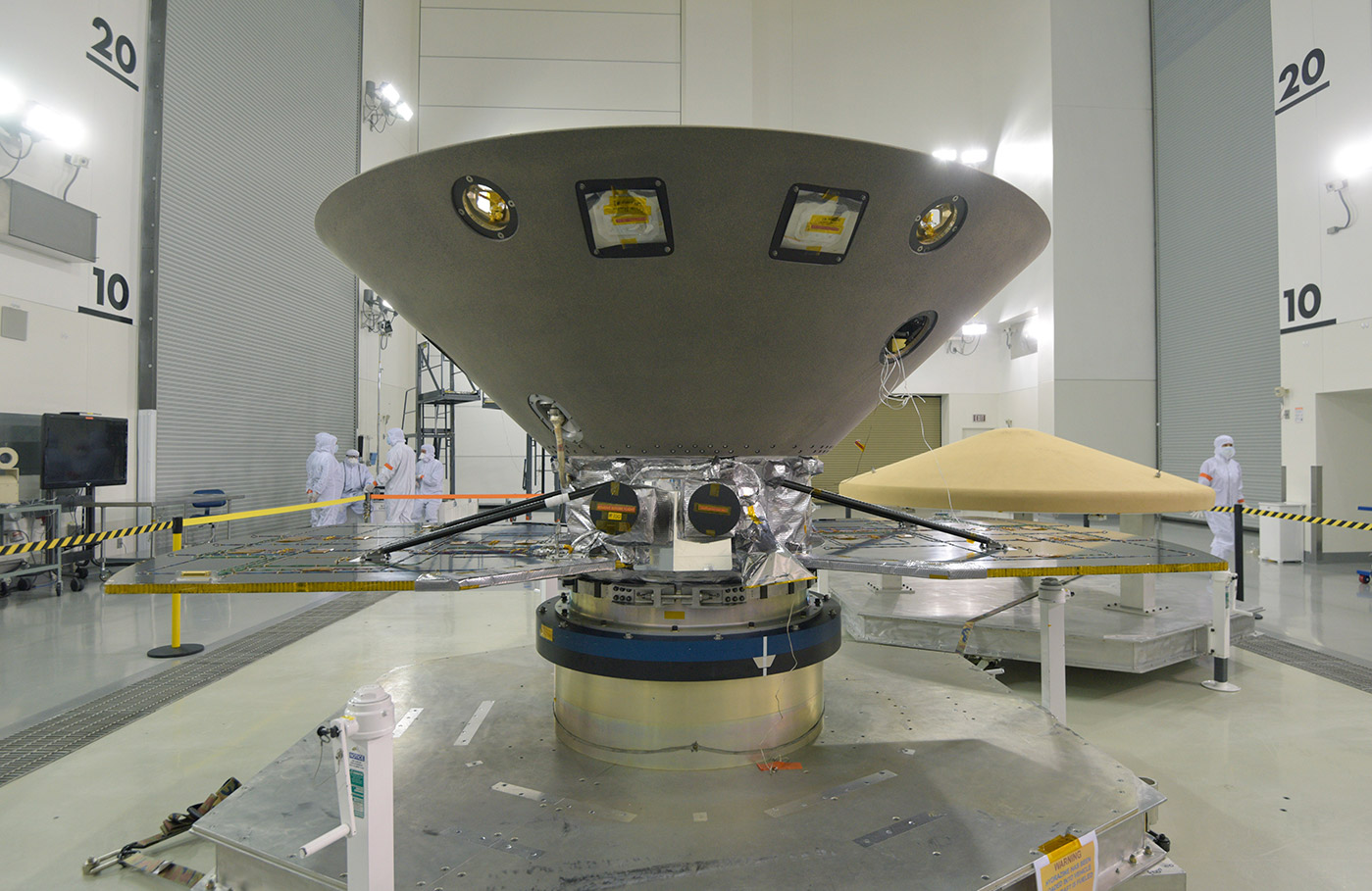
Don’t Dirty the Clean Room
Ryan Hendrickson’s nightmare sounds a lot like the plot of a campy sci-fi film: Killer earthling bacteria hitch a ride on a U.S. spaceship and colonize Mars to disastrous effect. But as a lead scientist in NASA’s Office of Planetary Protection, his job is to prevent that exact scenario.
Hendrickson explained to a dozen journalists packed in a Vandenberg conference room that, per the landmark 1967 Outer Space Treaty — and to preserve the very integrity of our solar system — NASA must avoid contaminating other celestial bodies with Earth life. This ensures our ability to study other worlds as they exist in their natural states, said Hendrickson, and prevents the potential infection of otherwise pristine alien environments. That means taking extreme safety precautions before any one of us germy reporters is allowed near InSight.
“We’re worried about the heartiest microorganisms we know about,” said Hendrickson. “Endospores.” These microscopic, airborne buggers, he explained, are everywhere, and they behave a bit like bears. If they were to find their way onto an inhospitable surface with no food, like one of InSight’s smooth metal panels, they would go into hibernation and could stay that way for literally millions of years until they found a more livable habitat.
Hendrickson said for this particular mission, only 300,000 spores are allowed to land on InSight. That may sound like a lot, but think about it this way: Each spore is about one micron in size, and 300,000 piled together could fit on a hangnail. With its solar panels extended, InSight is 20 feet long. In the weeks leading up to the launch, each piece of equipment is meticulously swabbed and tested. If one comes up contaminated, it’s taken apart, cleaned, and reinstalled. If the Planetary Protection team fails to keep the spore count down, the entire mission is scrubbed.
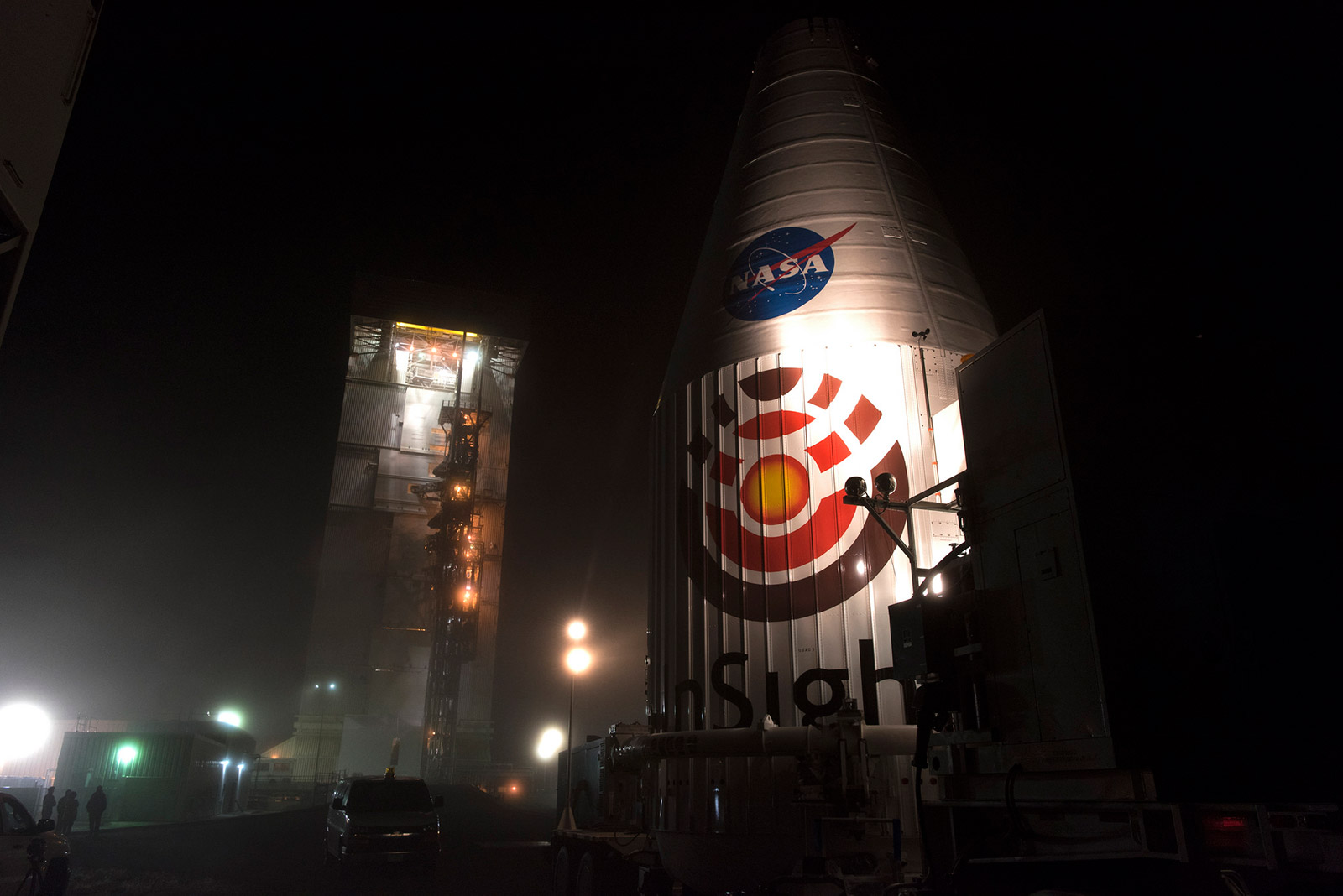
There were lots of ground rules for the InSight clean room. We weren’t allowed to bring in paper, pens, or pencils; wear jewelry or makeup; have on aftershave or sunscreen; or carry any type of transmitting device, such as a phone or car key fob. Once inside, Hendrickson told us, move slowly, stay behind the black-and-yellow tape, and keep your hands to yourself. If you drop something, leave it. Don’t scratch any itches, and if you have to sneeze, do it away from the hardware. Don’t try and cover your mouth, because the extra movement could stir up even more particles. Above all, another scientist deadpanned, don’t lick the lander.
With that, we were whisked by van to a nondescript gray building toward the west end of the base, where I completed the awkward process of covering myself head to toe in protective gear. First, I walked across a sticky white doormat that grabbed dirt from the bottom of my feet. Then I stuck my shoes in an electric brush cleaner before slipping blue booties over them. In the next room I donned a face mask and hood.
After that, a gracious but serious Planetary Protection specialist showed me how to find my way into a pair of blue coveralls without letting any of the fabric touch the ground. It took every bit of my balance to not fall over. Once dressed, I sat on a bench that separated the clean and dirty sides of the room. Only after I’d cinched up a pair of thin boots on the dirty side could I swing my legs over to the clean area.
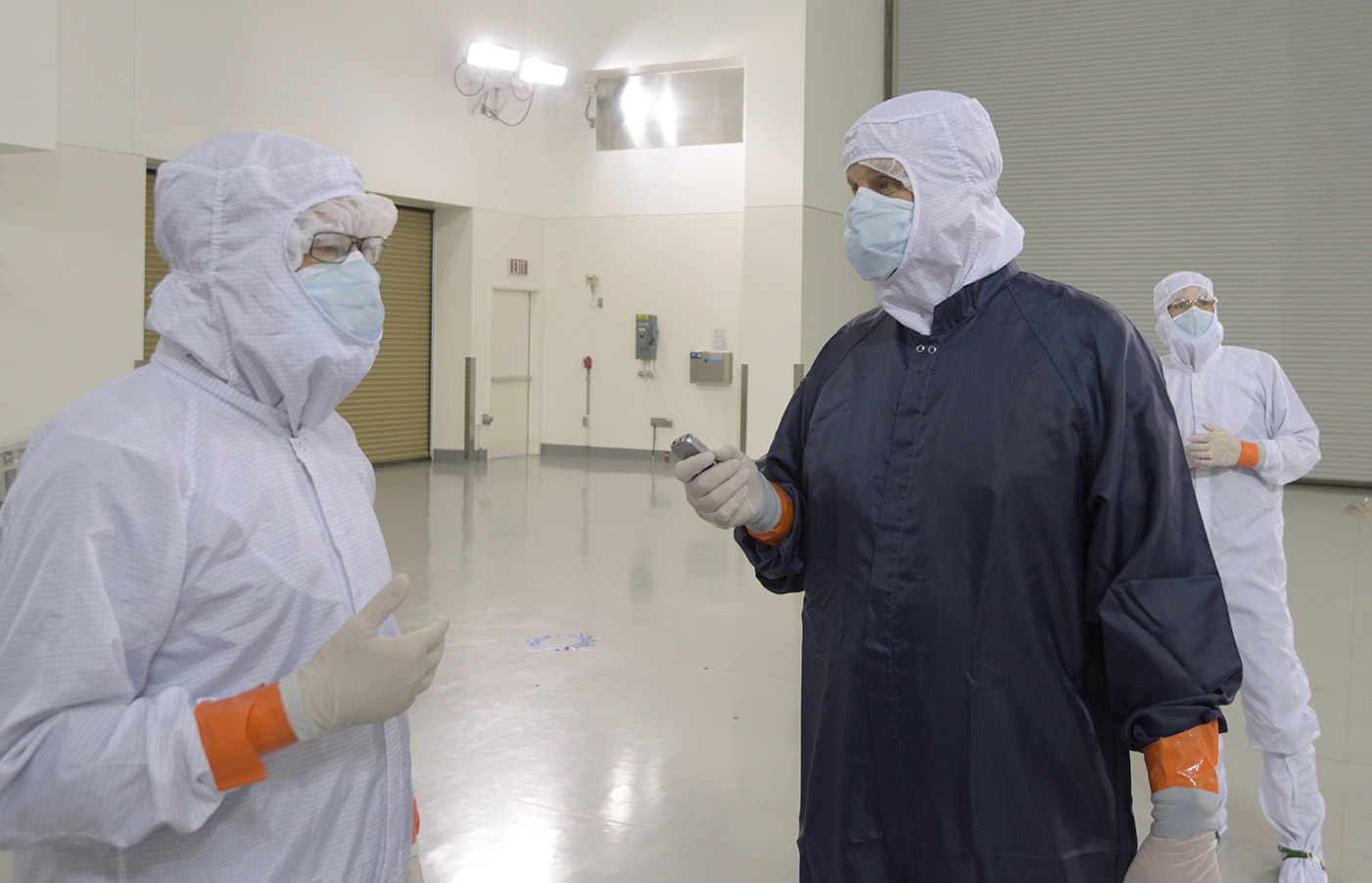
Now, with gloves on that were taped at the wrists, I shuffled into a tiny closet space fitted with dozens of air vents that blasted me as I turned slowly in a circle. A few seconds later I heard a click, and a door on the opposite side opened to reveal an impossibly white, high-ceilinged room echoing with the soft voices of scientists gathered around a low pedestal that cradled a gleaming InSight. Only their eyes were visible, peeking through their headgear. I headed toward what I thought looked like the kindest pair.
Dr. Bruce Banerdt is the mission’s principal research scientist. It’s really his baby. While NASA has documented the exterior of Mars with orbiters and looked at the history of its water and atmosphere with rovers, Banerdt mumbled through his mask, “There’s one big hole in our understanding, and that’s everything below the top two feet of the surface.”
InSight’s development journey has been a long and sometimes painful one, he went on. The two Viking landers that made it to Mars in the 1970s both carried seismometers meant to study the planet’s innards, but one broke and the other sent back unusable data. After that, NASA started prioritizing life-finding missions. Geophysicists like Banerdt, however, kept lobbying for another crack. “I’ve been pushing this for decades, since about 1990,” he said. “I’m sure people got sick of hearing me.”
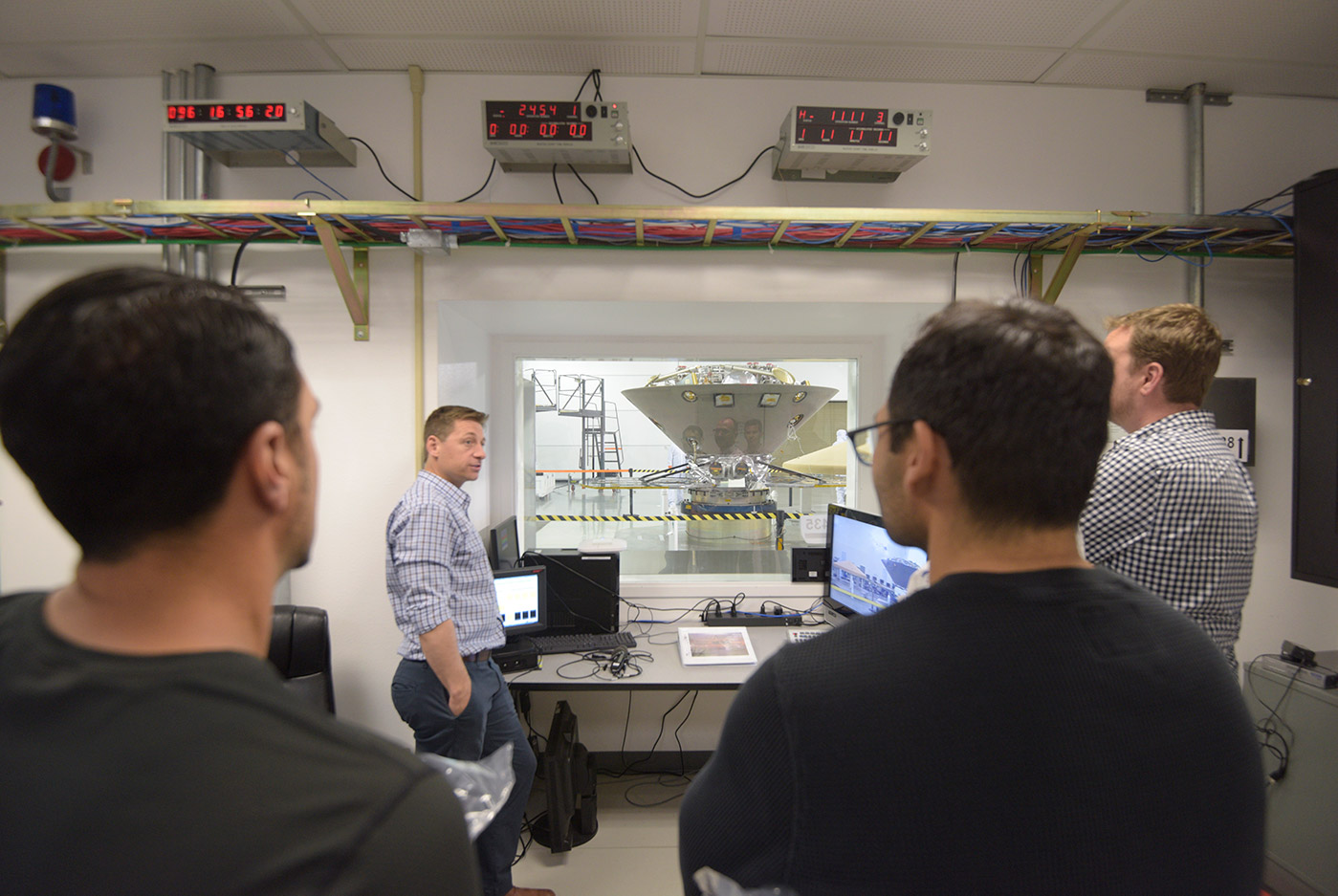
As a graduate student, Banerdt worked on projects that examined the dynamics and forces of Mars’s rocky constitution. He studied the contours of mountains and depressions in the landscape to get a better understanding of how the planet formed and changed during its early existence. “But I was always kind of beating my head against the wall because all my models required the thickness of the Martian crust,” he said. “It was so frustrating.”
InSight should provide Banerdt with the missing piece of his research puzzle. “This is basically the culmination of my entire scientific career,” he said. (At this point in our interview, Banerdt started to gesticulate with his hands until another NASA scientist gently reminded him to keep his movements to a minimum. For the rest of our conversation, he sheepishly held his arms to his sides.) Banerdt is confident that InSight’s engineers will land the nearly billion-dollar lander safely on Mars, but he knows in spaceflight, nothing is guaranteed. Only 40 percent of missions to the Red Planet are successful. “It’s gonna be pins and needles as we get close,” he said.

As InSight drops from its travel route into Mars’s atmosphere, it will be zooming along at about six times the speed of a high-velocity bullet, and its heat shield will start to absorb vaporizing temperatures of 2,800 degrees Fahrenheit. The period of radio silence between entry and the end of the three-legged spacecraft’s descent, when it deploys parachutes and slows to a glide, is known among mission leaders as the Seven Minutes of Terror. “It’s definitely nerve-wracking,” said Tim Linn, a chief system engineer with Lockheed Martin, which built InSight. “But it’s not horrible. It’s just that everything has to go right.”
InSight was manufactured on the same platform as 2008’s Phoenix lander, Linn told me. “Phoenix was very, very successful, so we leveraged as much of that as we could.” The 1,530-pound rig is somewhat autonomous, he said, though mission control on Earth will be giving most of the orders. “Because the lag time between Earth to Mars is anywhere from 3 to 20 minutes, you can’t really joystick it,” he said, “but we can say, ‘Okay, now start this operation; now start that operation.’”
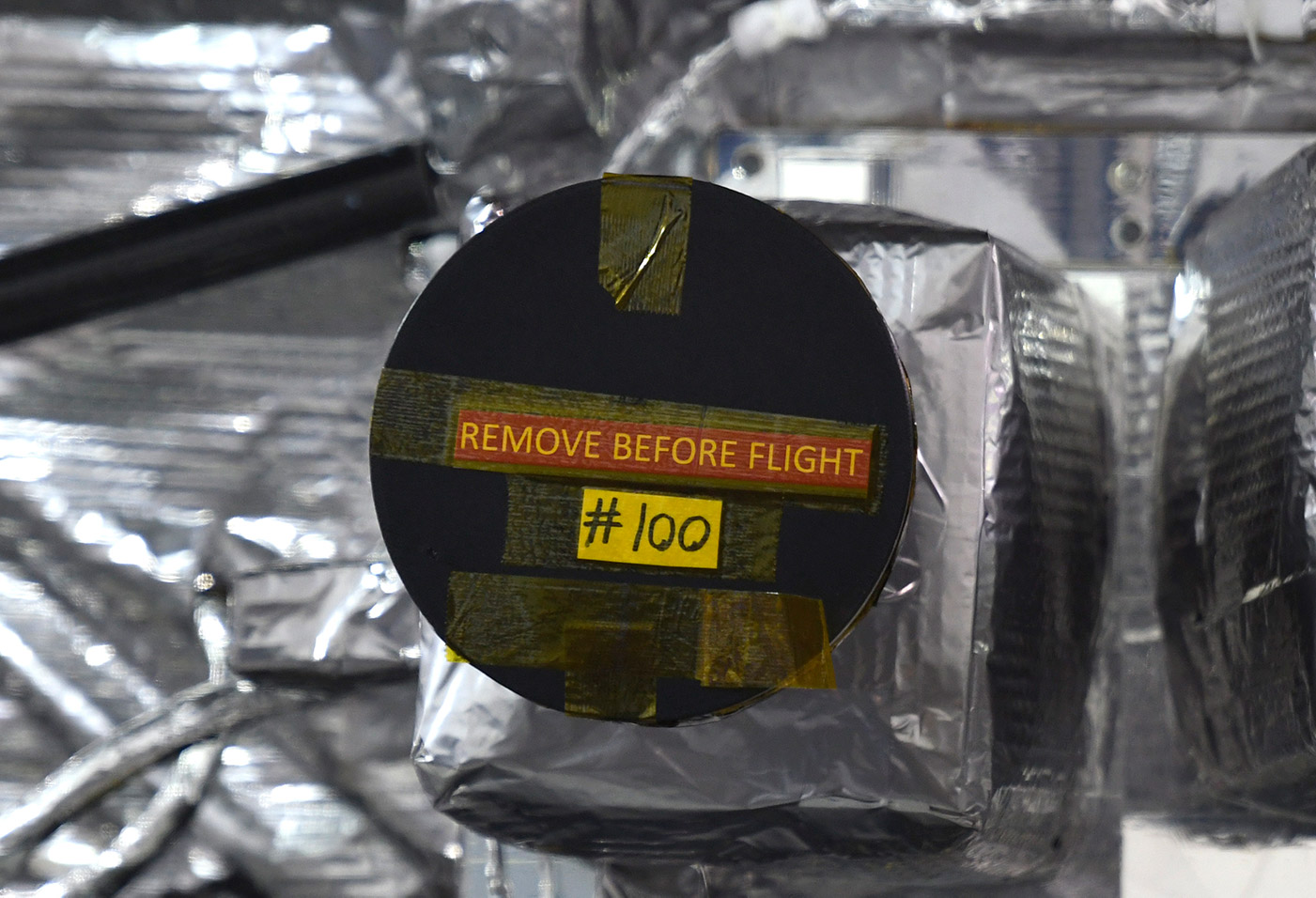
The trickiest part will be coordinating InSight’s robotic arm as it picks up instruments off its deck and gingerly places them on the ground. Linn described the landing site as a flat, open lava plain along the planet’s equator that will be perfect for digging and soaking up the solar power needed to run the whole InSight operation.
It can be difficult for the average person to wrap their head around the purpose and significance of the InSight expedition, Linn acknowledged. “I’ve had friends ask me: “Why are we going to Mars again? What’s in it for me?’” The answer is twofold, he said. “One, Mars has preserved some of the prehistoric information about the evolution of our solar system four and a half billion years ago. Why did Mars end up the way it did — with a very nasty atmosphere and much colder than Earth? Why is Earth so habitable for life? This mission is going to address some of those questions. It’s going to tell us more about where our planet is headed someday.”
“Two,” Linn continued, “I always like to talk about all the technology that comes out of these missions. A lot of microelectronics find their way into GPS satellites, weather satellites, medical equipment — things that every day people rely on.” Plus, he explained, Mars exploration gets kids excited and inspired. “They think, ‘Wow, I want to do that someday.’ It’s really neat.”
At that, a NASA media handler ushered me toward the clean-room exit so other reporters could speak with Banerdt and Linn. I’d been inside just 20 minutes but was already sweaty and uncomfortable. I couldn’t wait to tear off the extra layer of clothing. But I stayed calm and slowed my pace, making sure I took all my endospores out the door with me.

Careful Out There
Often the third-brightest object in our night sky, after the moon and Venus, Mars — the Greek god of war — isn’t a totally alien place. Just like Earth, it’s got gravity, an atmosphere, mountains, and even seasons. Still, everything about it is just a little bit different…
- Though Mars is about half the size of Earth, its gravity is only 38 percent as strong.
- It doesn’t seem to have a planet-wide magnetic field, only remnant pockets scattered across various regions.
- A year on Mars is 687 Earth days, but a Mars day is just longer than 24 hours.
- Atmosphere on the Red Planet is composed of carbon dioxide (95.3 percent), nitrogen (2.7 percent), and argon (1.6 percent).
- Light 5 mph surface winds can kick up small dust devils, or they can rage 90 mph and create global megastorms.
- Surface temperatures can fluctuate from -199 degrees Fahrenheit at night at the poles in the winter to 80 degrees Fahrenheit along the equator during the day in the summer.
- The highest point on Mars is Olympus Mons, a huge shield volcano about 16 miles high and 370 miles across; it takes up about the same area as Arizona.
- The canyon system of Valles Marineris — more than 2,500 miles long and up to four miles deep — is the largest and deepest in our solar system.
- Two irregularly shaped moons orbit the Red Planet, each only a few miles wide; named for the sons of Mars, the larger is Phobos (“fear”) and the smaller is Deimos (“terror”).
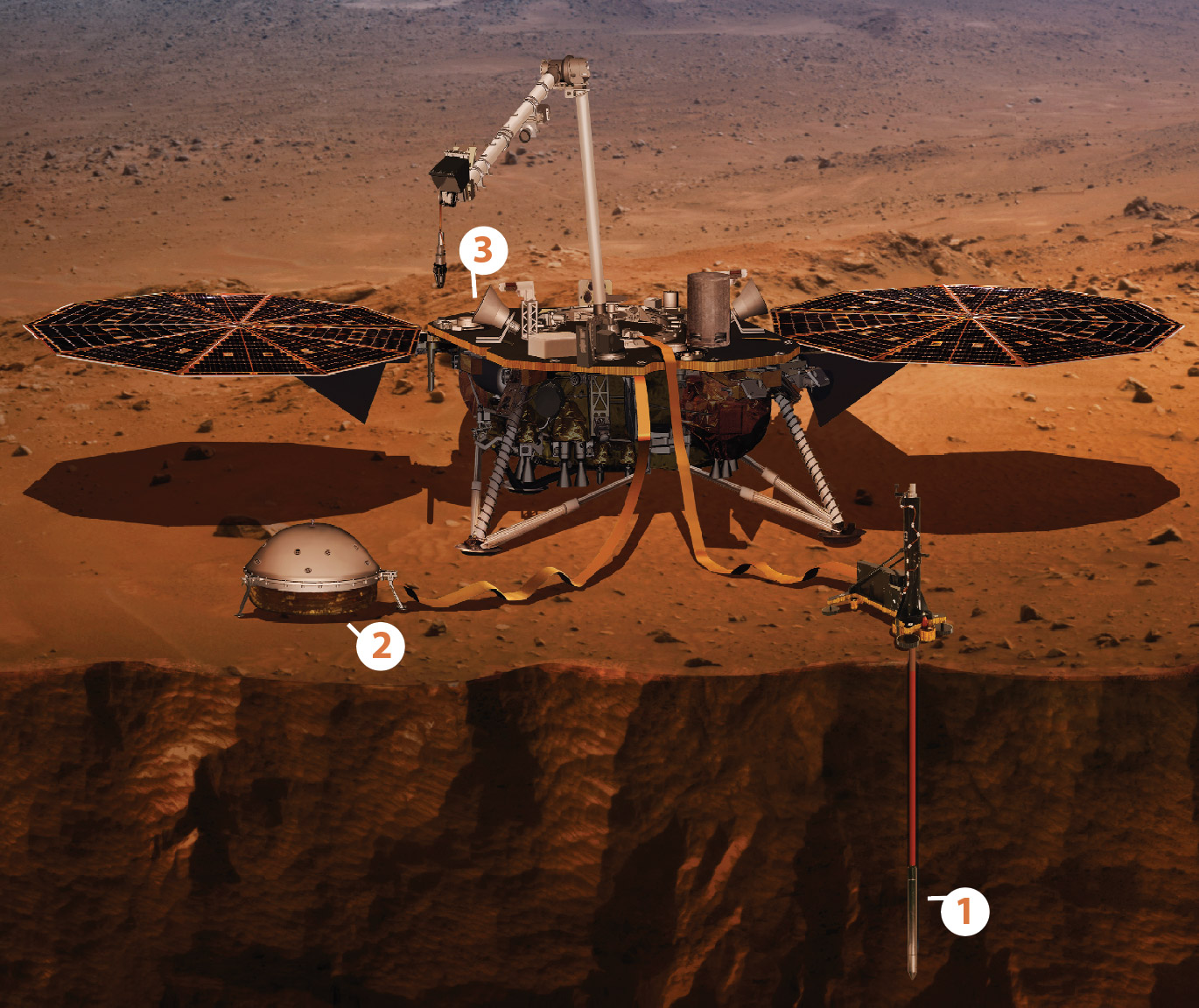
Talk Nerdy to Me
InSight holds three pieces of equipment it will use to crack the code of the Mars interior: a seismometer, a heat probe, and radio antennae. Once it sets down on the Red Planet on November 26, the car-sized lander will spend the next 10 weeks using its robotic arm to very carefully pluck the first two devices from inside the craft and gently lay them nearby, but not too close, or else noise from InSight could throw off their readings. The radio antennae stay onboard.
1, Heat Probe: Perhaps the most sophisticated and expensive thermometer ever created, InSight’s heat probe will burrow as deep as 16 feet into the Martian soil with thousands of strokes of a tiny tungsten hammer. The German-built probe — the diameter of a quarter and as long as your forearm — will measure the intensity and rate of heat escaping the planet’s interior, which will tell scientists a lot about the evolution of the rocky body, including when its volcanoes were most active.
2, Seismometer: About as big as a volleyball and covered with a domed shield to protect it from wind and heat, this gadget fabricated by France’s Centre National d’Études Spatiales will track marsquakes. Unlike earthquakes, which are caused by shifting tectonic plates, scientists think marsquakes could be triggered by underground volcanic activity or meteor impacts. Each tremor, NASA says, will be like a flashbulb illuminating the structure of the planet’s belly, and by studying how seismic waves pass through its crust, mantle, and core, researchers can deduce the depths of these layers and what they’re made of.
3, Radio Antennae: NASA will periodically send radio broadcasts from Earth to InSight and measure tiny Doppler shifts in the signal. This will reveal how much the planet wobbles on its axis and therefore how large and dense its iron-rich core is compared to its mantle. That data, in turn, could also tell researchers whether Mars is cooling from the inside out, like Earth, or from the outside in.
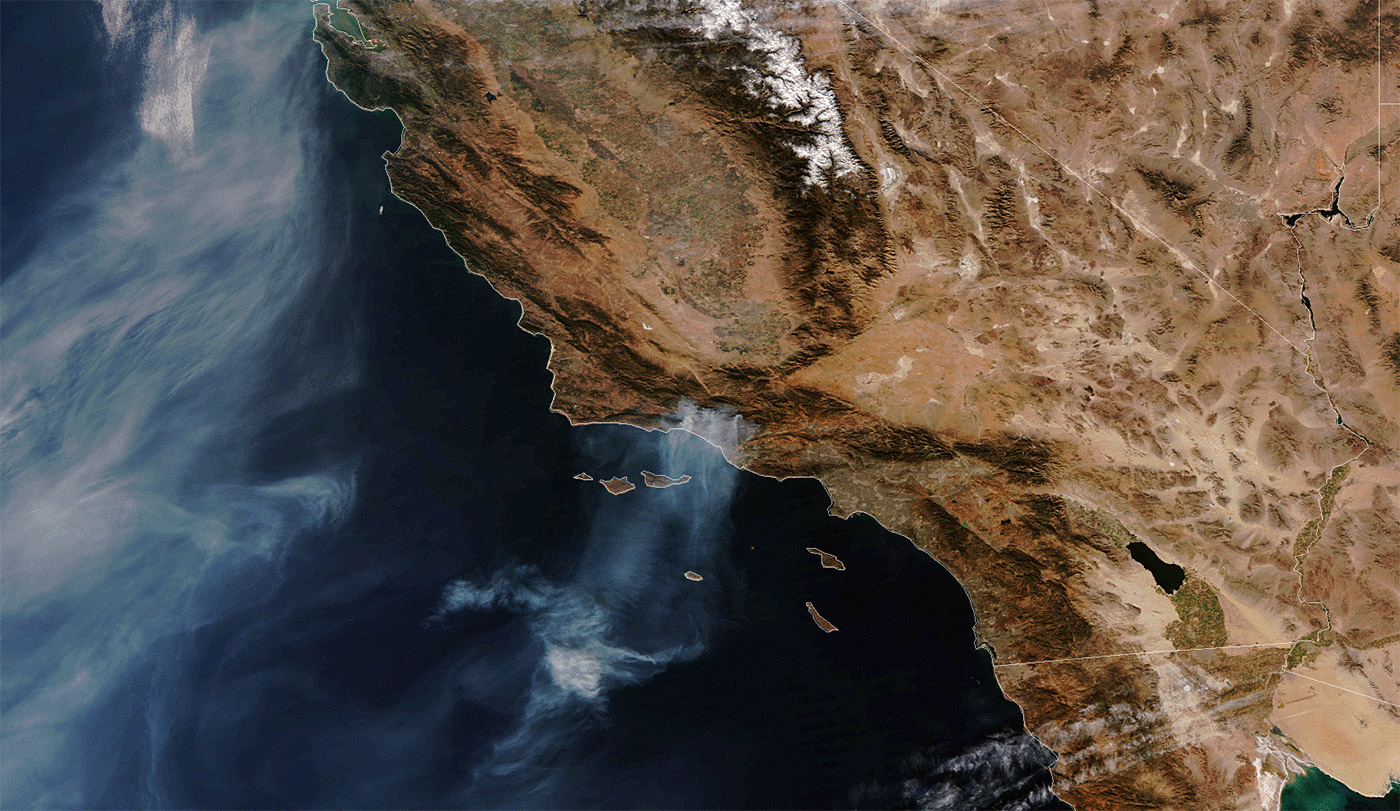
Silly with Science
InSight is hardly NASA’s first venture from Vandenberg. Here are the other science-gathering spacecraft launched from our Santa Barbara County base in the last five years.
IRIS (2013): The Interface Region Imaging Spectrograph observes how solar material moves, gathers energy, and heats up as it travels through a little-understood region in the sun’s lower atmosphere. Tracking this may help us cope with the sun-powered space weather that disrupts human technology.
OCO II (2014): The Orbiting Carbon Observatory–2 watches the Earth breathe from space, studying carbon dioxide concentrations and distributions in our atmosphere. The data is critical to knowing exactly how greenhouse gases are warming the planet.
SMAP (2015): The Soil Moisture Active Passive satellite measures the amount of water in the top two inches of soil everywhere on Earth’s surface, where the food we eat grows and where other vegetation lives. Scientists use this information to monitor droughts, improve weather forecasts, and increase crop productivity.
Jason-3 (2016): This is the fourth installment in a series of U.S.-European satellite missions that measure the height of ocean surface down to the literal inch, which is a critical component in understanding sea-level rise and Earth’s ever-changing climate.
JPSS-1 (2017): A collaboration between the National Oceanic and Atmospheric Administration and NASA, the Joint Polar Satellite System–1 (known as NOAA-20 after it entered orbit) collects a massive array of data. JPSS satellites circle the Earth from pole to pole 14 times daily to measure atmospheric, terrestrial, and oceanic conditions; concentrations of vegetation, clouds, rainfall, snow, and ice; fire locations and smoke plumes; and the location of water vapor and ozone. All of this data helps scientists predict severe weather and assess immediate hazards.
